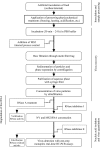Effects of technological processes on the tenacity and inactivation of norovirus genogroup II in experimentally contaminated foods
- PMID: 19933338
- PMCID: PMC2805205
- DOI: 10.1128/AEM.01797-09
Effects of technological processes on the tenacity and inactivation of norovirus genogroup II in experimentally contaminated foods
Abstract
Contaminated food is a significant vehicle for human norovirus transmission. The present study determined the effect of physicochemical treatments on the tenacity of infective human norovirus genogroup II in selected foods. Artificially contaminated produce was subjected to a number of processes used by the food industry for preservation and by the consumer for storage and preparation. Virus recovery was carried out by using ultrafiltration and was monitored by using bacteriophage MS2 as an internal process control. Norovirus was quantified by using monoplex one-step TaqMan real-time reverse transcription (RT)-PCR and an external standard curve based on recombinant RNA standards. An RNase pretreatment step was used to avoid false-positive PCR results caused by accessible RNA, which allowed detection of intact virus particles. Significant reductions in titers were obtained with heat treatments usually applied by consumers for food preparation (baking, cooking, roasting). Generally, processes used for preservation and storage, such as cooling, freezing, acidification (>or=pH 4.5), and moderate heat treatments (pasteurization), appear to be insufficient to inactivate norovirus within a food matrix or on the surface of food. Besides data for persistence in processed food, comparable data for individual matrix-specific protective effects, recovery rates, and inhibitory effects on the PCRs were obtained in this study. The established procedure might be used for other noncultivable enteric RNA viruses that are connected to food-borne diseases. The data obtained in this study may also help optimize the process for inactivation of norovirus in food by adjusting food processing technologies and may promote the development of risk assessment systems in order to improve consumer protection.
Figures
Similar articles
-
Enhanced reverse transcription-PCR assay for detection of norovirus genogroup I.J Clin Microbiol. 2006 Aug;44(8):2714-20. doi: 10.1128/JCM.00443-06. J Clin Microbiol. 2006. PMID: 16891482 Free PMC article.
-
Evaluation of heat treatment for inactivation of norovirus genogroup II in foods.Braz J Microbiol. 2022 Sep;53(3):1159-1165. doi: 10.1007/s42770-022-00731-3. Epub 2022 Mar 21. Braz J Microbiol. 2022. PMID: 35312990 Free PMC article.
-
Real-time RT-PCR for norovirus screening in shellfish.J Virol Methods. 2005 Jan;123(1):1-7. doi: 10.1016/j.jviromet.2004.08.023. J Virol Methods. 2005. PMID: 15582692
-
[Current topics on inactivation of norovirus].Kokuritsu Iyakuhin Shokuhin Eisei Kenkyusho Hokoku. 2011;(129):37-54. Kokuritsu Iyakuhin Shokuhin Eisei Kenkyusho Hokoku. 2011. PMID: 22259842 Review. Japanese.
-
Reduction of Norovirus in Foods by Nonthermal Treatments: A Review.J Food Prot. 2020 Dec 1;83(12):2053-2073. doi: 10.4315/JFP-20-177. J Food Prot. 2020. PMID: 32649759 Review.
Cited by
-
A Bibliometric Analysis of the Literature on Norovirus Disease from 1991-2021.Int J Environ Res Public Health. 2022 Feb 22;19(5):2508. doi: 10.3390/ijerph19052508. Int J Environ Res Public Health. 2022. PMID: 35270203 Free PMC article.
-
Evaluation of a Proteinase K-Based Extraction Method to Detect Hepatitis A Virus, Hepatitis E Virus and Norovirus in Artificially Contaminated Dairy Products.Foods. 2023 Apr 1;12(7):1489. doi: 10.3390/foods12071489. Foods. 2023. PMID: 37048310 Free PMC article.
-
Impact of Sodium Chloride, Sucrose and Milk on Heat Stability of the Murine Norovirus and the MS2 Phage.Food Environ Virol. 2013 Apr 28. doi: 10.1007/s12560-013-9112-6. Online ahead of print. Food Environ Virol. 2013. PMID: 23625486
-
Current and Emerging Technologies for the Detection of Norovirus from Shellfish.Foods. 2019 May 31;8(6):187. doi: 10.3390/foods8060187. Foods. 2019. PMID: 31159220 Free PMC article.
-
Establishment of Repertoire of Placentome-Associated MicroRNAs and Their Appearance in Blood Plasma Could Identify Early Establishment of Pregnancy in Buffalo (Bubalus bubalis).Front Cell Dev Biol. 2021 Aug 26;9:673765. doi: 10.3389/fcell.2021.673765. eCollection 2021. Front Cell Dev Biol. 2021. PMID: 34513824 Free PMC article.
References
-
- Ausar, S. F., T. R. Foubert, M. H. Hudson, T. S. Vedvick, and C. R. Middaugh. 2006. Conformational stability and disassembly of Norwalk virus-like particles. Effect of pH and temperature. J. Biol. Chem. 281:19478-19488. - PubMed
-
- Baert, L., J. Debevere, and M. Uyttendaele. 2009. The efficacy of preservation methods to inactivate foodborne viruses. Int. J. Food Microbiol. 131:83-94. - PubMed
Publication types
MeSH terms
LinkOut - more resources
Full Text Sources
Medical


